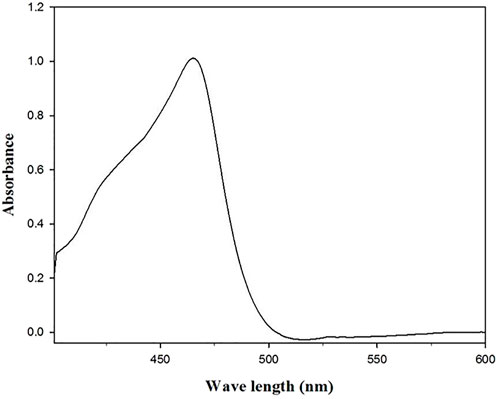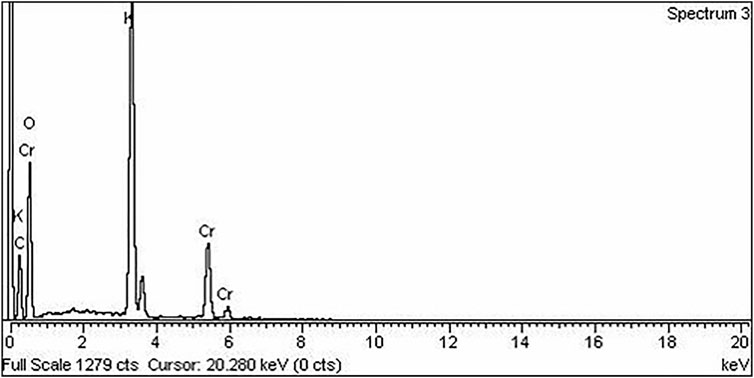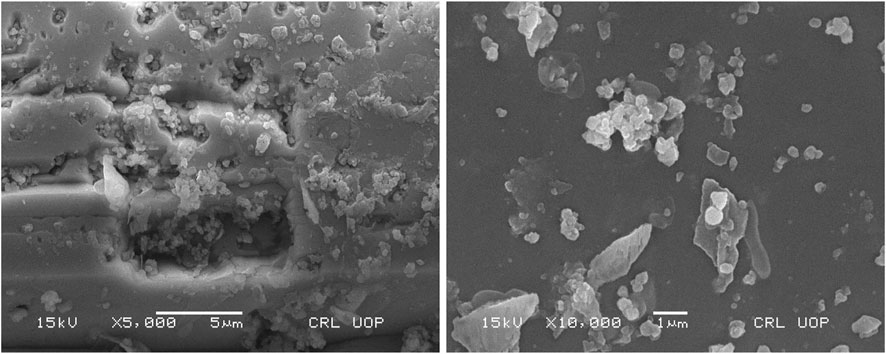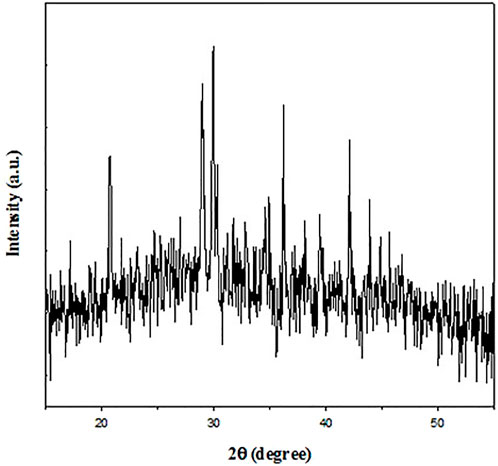- 1Department of Chemistry, University of Malakand, Charsadda, Khyber Pakhtunkhwa, Paksitan
- 2College of Chemistry and Materials Science, Hebei Normal University, Shijiazhuang, China
- 3Department of Pharmacy, Shaheed Benazir Bhutto University Sheringal, Dir (Upper), Khyber Pakhtunkhwa, Pakistan
- 4Department of Chemistry, Bacha Khan University, Charsadda, Khyber Pakhtunkhwa, Pakistan
- 5Department of Clinical Laboratory Sciences, College of Applied Medical Sciences, Taif University, Taif, Saudi Arabia
The conventional chemical methods of nanoparticles synthesis have been effectively replaced by nanoparticle synthesis mediated by plants. The current study describes the environmental friendly synthesis of chromium oxide nanoparticles (Cr2O3 NPs) using Erythrophleum guineense plant extract. The synthesis of Cr2O3 NPs was validated by UV/VIS spectroscopy, Energy Dispersive X-Ray (EDX), Scanning Electron Microscopy (SEM), and X-ray diffraction (XRD) studies. The appearance of the Sharpe peak at 460 nm in the UV/Vis spectrum and the colour change caused by surface plasma resonance confirmed the formation of Cr2O3 NPs. The EDX spectrum of Cr2O3 nanoparticles revealed the presence of carbon, oxygen, and chromium, while SEM analysis revealed an irregular round morphology (with a size below 400 nm). In addition, XRD studies suggested their crystalline nature by the characteristic peaks at 34° and 36° and 42° (2Ɵ), respectively. The green synthesized Cr2O3 NPs showed promise as in-vitro cholinesterase inhibitor at tested concentrations (62.5–1,000 μg/ml), with IC50 values of 120 and 100 μg/ml against Acetylcholinesterase (AChE) and Butyrylcholinesterase (BChE), respectively. The results suggested that the green synthesized Cr2O3 NPs could be used in the future to stop enzyme from working and for other biological activities.
Introduction
Nanotechnology is an emerging field in biomedical sciences as the number of its applications in health care sciences increases (Khan et al., 2016a). Nanotechnology is a fast expanding field that utilizing nanomaterials for diagnosis and treatment purposes (Sargazi et al., 2022). The development of nanomaterials is one of the most promising advances for the treatment of a wide range of illnesses, such as fungal and bacterial infections, as well as various types of cancer (Khan et al., 2016b; Khan et al., 2017b). Nanoparticles (NPs) remarkable physicochemical features, including minute sizes, large surface-to-volume ratios, and size-dependent optical properties, have received considerable attention in potential increased biological applications (Sengul and Asmatulu, 2020; Yaqoob et al., 2020). NPs are the building blocks of nanotechnology and nanomedicine, they have been employed in a variety of applications, including diagnosis, detection, drug delivery, and treatment of various diseases, and treatment of different types of cancer (Khan et al., 2017a). For example, metal oxide NPs are utilized extensively in various products for different purposes (Khan et al., 2015), like photocatalysis (Mahmood et al., 2021) adsorption (Riaz et al., 2022), and enzyme inhibition (Ashraf et al., 2021) etc.
Due to their excellent stability, hardness, high resistivity, high melting temperature, and wide bandgap of 3.4 eV, chromium oxide nanoparticles (Cr2O3) have grained particular among metal oxide NPs (Iqbal et al., 2020; Isacfranklin et al., 2020). Cr2O3 NPs could be used in materials for catalysis (Mori et al., 2017), photocatalysis (Zelekew et al., 2021), super capacitors (Shafi et al., 2021), lithium ion batteries (Cao and Zuo, 2017), sensing (Gao et al., 2019), and other biological activities due to their unique properties (Talat et al., 2021). Biocompatibility of Cr2O3 nanoparticles is an essential parameter for their use in many biological systems (Khan et al., 2021). Medically Cr2O3 NPs were significantly utilized as potent anti-oxidants, anti-bacterial, anti-cancer, anti-viral and anti-diabetic etc. (Rayani Nivethitha and Carolin Jeniba Rachel, 2020; Ghotekar et al., 2021; Khan et al., 2021), drug delivery (Azizi, 2020) etc. Due to the substantial usage of hazardous chemicals, both as solvents and starting materials, along with considerable heat and pH fluctuations, the Cr2O3 NPs prepared by conventional chemical or physical procedures exhibits a number of disadvantages (Bahrulolum et al., 2021; Zainab et al., 2021). The usage of such parameters imparts additional hazardous properties, including as carcinogenicity and environmental toxicity, that restrict the deployment of nanoparticles in various clinical and biomedical applications (Zhang et al., 2020).
Thus the green synthesis of nanoparticles has developed as an alternative to conventional physical and chemical methods and has the potential to mitigate some of their damaging impacts (Ahmad et al., 2022). Green synthesis is a fascinating method for producing nanoparticles since it is straightforward, cost-effective, and eco-friendly (Aravind et al., 2021). Biological synthesized metallic NPs are cancer-fighting cytotoxic agents (Patil and Chandrasekaran, 2020). Compared to the synthesis of nanoparticles by bacteria and fungus, the synthesis of nanoparticles using plant extracts is a simple and straightforward approach for producing nanoparticles on a large scale (Singh et al., 2018). Numerious researchers are now interested in green synthesis of chromium oxide nanoparticles (Cr2O3 NPs) using plant extracts (Liu et al., 2021). Callistemon viminalis (Bottle Brush), flower extracts (Hassan et al., 2019), Tridax procumbens Leaf Extract (Ramesh et al., 2012), cactus (Opuntia ficus-indica) plant extract (Tsegay et al., 2021), etc. have been used in the production of Cr2O3.
The widely distributed plant E. guineense belongs to the Caesalpiniaceae family and has been used to treat cardiovascular diseases owing to its analgesic and anti-inflammatory characteristics (Ngounou et al., 2005). E. guineense, which is phytochemically abundant in glycosidic alkaloids and polyphenols (Nwude and Chineme, 1980; Adeoye and Oyedapo, 2004) is an effective agent for reducing metal ions. Prior to this study, various plant extracts were used for the green synthesis of Cr2O3 NPs, including Hyphaene thebaica (Mohamed et al., 2020), Rhamnus virgata (J et al., 2020), Cannabis sativa (Sharma and Sharma, 2021), Manihot esculenta (Thara et al., 2022) but there was no report on the use of E. guineense extract. In the present studies, E. guineense extract mediated Cr2O3 NPs were synthesized and characterized by UV/Vis spectroscopy, EDX, SEM, and XRD techniques along with evaluation of them in vitro cholinesterase inhibitory potential.
Experimental work
Materials
As chemical, methanol (commercial grade, double distilled), deionized water, and Chromium chloride (Sigma, Germany) were used as chemicals.
Samples collections and preparation
Professor Dr. Mehboob Ur Rehman, Department of Botany, Jehanzeb Post Graduate Collage, Swat, KPK, Pakistan, gathered 4 km of E. guineense aerial parts from his natural habitat in Nigeria after carefully identifying them. A voucher specimen (accession # EG016o the department’s herbarium.
The materials were ground to powder using an electrical blender and extracted thrice with 80% methanol in a cold maceration manner (3 × 10 days). The crude extract was obtained by concentrating on a rotary evaporator (40°C) and was used to synthesize Cr2O3 NPs.
Synthesis of chromium nanoparticles
A crude extract solution of 0.5% E. guineense was prepared in deionized water and filtered thrice to remove any suspended particles. The clear solution of plant extract and chromium chloride salt solution (0.2 M) were placed in a 250 ml conical flask (ratio of 3:7) and were magnetically stirred for 1.5 h at 100°C. The formation of NPs was thoroughly monitored by color change. After allowing the solution to cool, the Cr2O3 NPs were separated by centrifugation (13,500 rpm at 4°C) followed by drying in an oven (80°C). The maximum nanoparticles formed in a suspension was determined using UV-Visible spectrophotometer.
Characterization
The UV/VIS study of Cr2O3 NPs was obtained through a UV/Vis spectrophotometer (UV-1800, Shimadzo, Japan), while the EDX analyses were carried out on an EDX machine (INCA 200, Oxford instruments, UK). The surface morphology of Cr2O3 NPs was performed on SEM [JEOL, JSM-5910 SEM (high vacuum mode)]. The phase and crystal structure analysis were performed through XRD (JDX-3532, JEOL, Japan).
Acetylcholinesterase and butyrylcholinesterase inhibition assays
Sigma Aldrich provided all of the enzymes and chemicals required for the experiment. The enzyme (AChE/BChE) inhibition activities were measured using the spectrophotometric method as described in the literature [21]. Throughout, the reported protocol and assay conditions were followed [22]. This experiment included several dilutions of Cr2O3 NPs (1,000, 500, 250, 125, and 62.5 μg/ml). The substrates butyryl choline chloride (BChCl) and acetyl choline iodide (AChI) were used to evaluate BChE and AChE inhibitory activities, respectively.
Briefly, solution A containing DTNB (0.2 mM) in 62 mM sodium phosphate buffer (pH 8.0, 880 μl) was combined with solution B, the test sample (40 μl), and either acetyl cholinesterase or butyryl cholinesterase solution (40 μl) and incubated at 25°C 15 min. The experimental reactions were initiated by the addition of 40 μl ACh or BCh, and the hydrolysis of ACh or BCh was witnessed at 412 nm with (BMS-USA) spectrophotometer. Concentrations of the tested compounds which inhibit the hydrolysis of ACh and BCh (substrates) by 50% (IC50) were determined by observing the effect of an increase in concentrations of the compound on the inhibition values (Ellman et al., 1961; Rocha et al., 1993).
Results and discussion
UV/Vis study
Also, UV/Vis spectrophotometry was used to confirm the synthesis of chromium oxide nanoparticles. Figure 1 depicts the UV/Vis spectra of chromium oxide nanoparticles extracted from E. guineense. In the visible spectrum, there was a prominent peak at around 460. The emergence of peaks indicates that plant extract greatly decreased the quantity of chromium salt into oxide nanoparticles. Similarly, Jaswal et al. (2014) also reported a similar UV/Vis spectrum for chromium oxide nanoparticles synthesized by the precipitation method from their precursor.
Elemental composition analysis
EDX is a type of analysis that is used to determine which elements are in a compound or material. Figure 2 depicts the EDX spectrum of green synthesized chromium nanoparticles and shows the presence of carbon, oxygen, and chromium in our synthesized Cr2O3 NPs.
Surface morphology studies
The SEM data is useful in obtaining information about nanascale materials, especially the shapes, sizes, dispersion, and other surface phenomena. The SEM also gives useful information regarding surface contaminations, spherulites, lamellae, crystallinity, and qualitative chemical analyses. Figure 3 shows the SEM micrographs of chromium nanoparticles. The SEM images depicts that the Cr2O3 NPs formed irregular round-shaped particles and dispersed as aggregates in sizes below 400 nm.
XRD study
XRD is a useful tool for characterizing nanomaterials and determining sample size and shape; identifying crystalline phases; preferential order and epitaxial growth of crystallites; and spacing between lattice planes. The XRD technique also able to differentiate crystalline, semi-crystalline, and amorphous materials. The XRD study was performed to determine the crystalline nature of Cr2O3 NPs. The XRD spectrum (Figure 4) presented characteristic peaks at 34°, 36°, and 42° (2Ɵ values), thus confirming the crystalline nature of our synthesized Cr2O3 NPs (Tsuzuki and McCormick, 2000).
Anticholinesterase inhibition of Cr2O3 nanoparticles
The neurotransmitters play a central role in the coordination of the body. According to the neuronal classification on the basis of neurotransmitters, the cholinergic system has a major role in the cognitive functions of the brain (Schliebs and Arendt, 2011). The degeneration of neurons or the low secretion of acetylcholine in the brain, particularly in the hippocampus, leads to cognitive disorders. Alzheimer’s disease is one of the leading cognitive dysfunctions (Parri et al., 2011). The anticholinesterase compounds have been proven to be effective in the mitigation of the symptoms of Alzheimer’s disease. These compounds block the enzyme responsible for the breakdown of acetylcholine and so increase their quantity and avoid the associated symptoms (Gadzhanova et al., 2010). A variety of bioactive compounds have been explored for their anticholinesterase potential. Wide attention has been focused on the synthesis and isolation of bioactive compounds having high efficacy against Alzheimer’s disease (Zeb et al., 2014; Ahmad et al., 2015; Sadiq et al., 2015). The solubility and bioavailability of the drug play an important role in the enhancement of the efficacy of the drug. The bioavailability in turn depends upon the particle size of the drugs used (Judy et al., 2012).
Table 1 represents the enzyme inhibitory potential of green synthesized Cr2O3 NPs. The Cr2O3 NPs in these experiments have shown good acetylcholinesterase (AChE) and butyrylcholinesterase (BChE) inhibitory activities. The highest activity recorded for these NPs against AChE was 71% at 1,000 μ/ml, followed by 64, 57, 51, and 43% at 500, 250, 125, and 62.5 g/ml, respectively. IC50 values shown by the test samples is 120 μ/ml while for the positive control galantamine IC50 was recorded as 17 μg/ml. These activities are almost similar to previously reported results for Bottlebrush flowers extract as a reducing agent (Hassan et al., 2019). These NPs also inhibited BChE at the highest concentration used; 73% of the enzyme was inhibited, while at the lowest concentration, 45% of the enzyme was inhibited. IC50 shown by the test NPs is 100 μg/mL as compared to the standard (18 μg/ml), lower than the previously reported (132.24 μg/ml) for plant synthesized NPs of chromium oxide (Hassan et al., 2019).
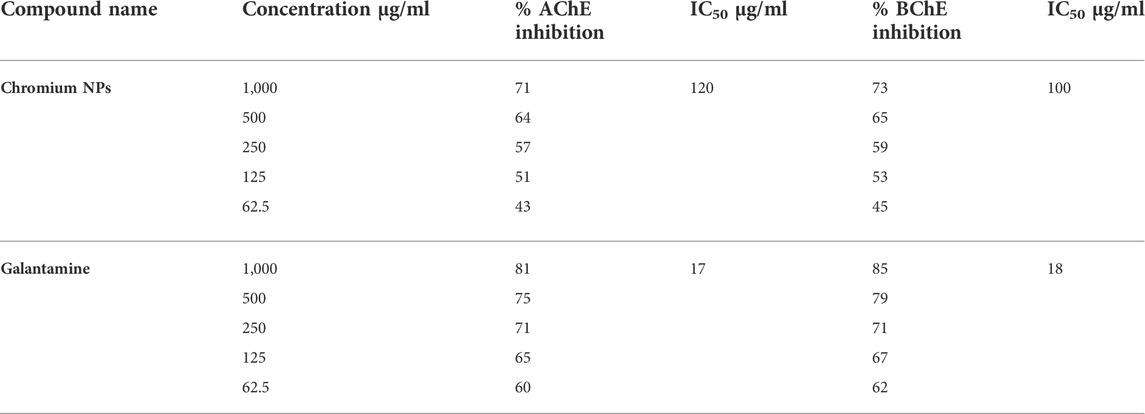
TABLE 1. Anti-cholinesterase inhibitory potential of chromium NPs compared with galantamine used as a standard.
Conclusion
Green synthesis was used to produce Cr2O3 NPs from their precursors, with E. guineense plant extracts serving as reducing agents. The morphological study illustrated that the size (below 400 nm) of chromium nanoparticles was similar while the E. guineense mediated chromium oxide nanoparticles were irregular and round in shapes. The EDX spectra represents peaks for carbon and oxygen along with chromium, thus confirming the reduction of chromium from precursor slat. The XRD and UV-VIS studies further confirmed the green synthesis of chromium oxide nanoparticles. The promising AChE and BChE inhibitory capabilities of our synthesised chromium oxide nanoparticles implies that such NPs could be used therapeutically in neurodegenerative illnesses, including Alzheimer’s disease.
Data availability statement
The original contributions presented in the study are included in the article/supplementary material, further inquiries can be directed to the corresponding authors.
Author contributions
All authors listed have made a substantial, direct, and intellectual contribution to the work and approved it for publication.
Funding
The research work was financially supported by Taif University, KSA (Project number: TURSP-2020/80).
Acknowledgments
The authors acknowledge University of Malakand for providing research work facilities and Taif University, KSA for their financial support.
Conflict of interest
The authors declare that the research was conducted in the absence of any commercial or financial relationships that could be construed as a potential conflict of interest.
Publisher’s note
All claims expressed in this article are solely those of the authors and do not necessarily represent those of their affiliated organizations, or those of the publisher, the editors and the reviewers. Any product that may be evaluated in this article, or claim that may be made by its manufacturer, is not guaranteed or endorsed by the publisher.
References
Adeoye, B., and Oyedapo, O. (2004). Toxicity of Erythrophleum guineense stem-bark: Role of alkaloidal fraction. Afr. J. Tradit. Complement. Altern. Med. 1. doi:10.4314/ajtcam.v1i1.31094
Ahmad, S., Ullah, F., Ayaz, M., Sadiq, A., and Imran, M. (2015). Antioxidant and anticholinesterase investigations of Rumex hastatus D. Don: Potential effectiveness in oxidative stress and neurological disorders. Biol. Res. 48, 20–28. doi:10.1186/s40659-015-0010-2
Ahmad, S., Zainab, Ahmad, H., Khan, I., Alghamdi, S., Almehmadi, M., Ali, M., et al. (2022). Green synthesis of gold nanaoparticles using Delphinium Chitralense tuber extracts, their characterization and enzyme inhibitory potential. Braz. J. Biol. 82, e257622. doi:10.1590/1519-6984.257622
Aravind, M., Amalanathan, M., and Mary, M. S. M. (2021). Synthesis of TiO2 nanoparticles by chemical and green synthesis methods and their multifaceted properties. SN Appl. Sci. 34 (3), 409–410. doi:10.1007/S42452-021-04281-5
Ashraf, N., Sumrra, S. H., Assiri, M. A., Usman, M., Hussain, R., Aziz, F., et al. (2021). Digera muricata (L.) Mart. mediated synthesis of antimicrobial and enzymatic inhibitory zinc oxide bionanoparticles. Green Process. Synthesis 10, 476–484. doi:10.1515/gps-2021-0044
Azizi, A. (2020). Green synthesis of Fe3O4 nanoparticles and its application in preparation of Fe3O4/cellulose magnetic nanocomposite: A suitable proposal for drug delivery systems. J. Inorg. Organomet. Polym. Mat. 309, 3552–3561. doi:10.1007/S10904-020-01500-1
Bahrulolum, H., Nooraei, S., Javanshir, N., Tarrahimofrad, H., Mirbagheri, V. S., Easton, A. J., et al. (2021). Green synthesis of metal nanoparticles using microorganisms and their application in the agrifood sector. J. Nanobiotechnology 19, 86–26. doi:10.1186/S12951-021-00834-3
Cao, Z., and Zuo, C. (2017). Cr2O3/carbon nanosheet composite with enhanced performance for lithium ion batteries. RSC Adv. 7, 40243–40248. doi:10.1039/C7RA06188A
Ellman, G. L., Courtney, K. D., Andres, V., and Featherstone, R. M. (1961). A new and rapid colorimetric determination of acetylcholinesterase activity. Biochem. Pharmacol. 7, 88–95. doi:10.1016/0006-2952(61)90145-9
Gadzhanova, S., Roughead, L., and MacKson, J. (2010). Anticholinesterase duration in the Australian veteran population. Aust. N. Z. J. Psychiatry 44, 469–474. doi:10.3109/00048670903555104
Gao, X., Zhou, Q., Lu, Z., Xu, L., Zhang, Q., and Zeng, W. (2019). Synthesis of Cr2O3 nanoparticle-coated SnO2 nanofibers and C2H2 sensing properties. Front. Mat. 0, 163. doi:10.3389/FMATS.2019.00163
Ghotekar, S., Pansambal, S., Bilal, M., Pingale, S. S., and Oza, R. (2021). Environmentally friendly synthesis of Cr2O3 nanoparticles: Characterization, applications and future perspective ─ a review. Case Stud. Chem. Environ. Eng. 3, 100089. doi:10.1016/J.CSCEE.2021.100089
Hassan, D., Khalil, A. T., Solangi, A. R., El-Mallul, A., Shinwari, Z. K., and Maaza, M. (2019). Physiochemical properties and novel biological applications of Callistemon viminalis ‐mediated α‐Cr 2 O 3 nanoparticles. Appl. Organomet. Chem. 33, e5041. doi:10.1002/AOC.5041
Iqbal, J., Ahsan Abbasi, B., Munir, A., Uddin, S., Kanwal, S., and Mahmood, T. (2020). Facile green synthesis approach for the production of chromium oxide nanoparticles and their different in vitro biological activities. Microsc. Res. Tech. 83 (6), 706–719. doi:10.1002/JEMT.23460
Isacfranklin, M., Ameen, F., Ravi, G., Yuvakkumar, R., Hong, S. I., Velauthapillai, D., et al. (2020). Single-phase Cr2O3 nanoparticles for biomedical applications. Ceram. Int. 46, 19890–19895. doi:10.1016/J.CERAMINT.2020.05.050
Jaswal, V. S., Arora, A. K., Kinger, M., Gupta, V. D., and Singh, J. (2014). Synthesis and characterization of chromium oxide nanoparticles. Orient. J. Chem. 30, 559–566. doi:10.13005/OJC/300220
Judy, J. D., Unrine, J. M., Rao, W., Wirick, S., and Bertsch, P. M. (2012). Bioavailability of gold nanomaterials to plants: Importance of particle size and surface coating. Environ. Sci. Technol. 46, 8467–8474. doi:10.1021/es3019397
Khan, S., Ansari, A. A., Khan, A. A., Abdulla, M., Al-Obaid, O., and Ahmad, R. (2017a). In vitro evaluation of cytotoxicity, possible alteration of apoptotic regulatory proteins, and antibacterial activity of synthesized copper oxide nanoparticles. Colloids Surf. B Biointerfaces 153, 320–326. doi:10.1016/J.COLSURFB.2017.03.005
Khan, S., Ansari, A. A., Khan, A. A., Abdulla, M., Al-Obeed, O., and Ahmad, R. (2016a). In vitro evaluation of anticancer and biological activities of synthesized manganese oxide nanoparticles. Medchemcomm 7, 1647–1653. doi:10.1039/C6MD00219F
Khan, S., Ansari, A. A., Khan, A. A., Ahmad, R., Al-Obaid, O., and Al-Kattan, W. (2015). In vitro evaluation of anticancer and antibacterial activities of cobalt oxide nanoparticles. J. Biol. Inorg. Chem. 20, 1319–1326. doi:10.1007/s00775-015-1310-2
Khan, S., Ansari, A. A., Khan, A. A., Al-Kattan, W., Al-Obeed, O., and Ahmad, R. (2016b). Design, synthesis and in vitro evaluation of anticancer and antibacterial potential of surface modified Tb(OH)3@SiO2 core–shell nanoparticles. RSC Adv. 6, 18667–18677. doi:10.1039/C5RA17906H
Khan, S., Ansari, A. A., Rolfo, C., Coelho, A., Abdulla, M., Al-Khayal, K., et al. (2017b). Evaluation of in vitro cytotoxicity, biocompatibility, and changes in the expression of apoptosis regulatory proteins induced by cerium oxide nanocrystals. Sci. Technol. Adv. Mat. 18, 364–373. doi:10.1080/14686996.2017.1319731
Khan, S. A., Shahid, S., Hanif, S., Almoallim, H. S., Alharbi, S. A., and Sellami, H. (2021). Green synthesis of chromium oxide nanoparticles for antibacterial, antioxidant anticancer, and biocompatibility activities. Int. J. Mol. Sci. 202122, 502. doi:10.3390/IJMS22020502
Liu, Q. Y., Bu, Z. Q., Yao, Q. F., Ding, X., Xia, L. Q., and Huang, W. T. (2021). Microwave-assisted synthesis of chromium oxide nanoparticles for fluorescence biosensing of mercury ions and molecular logic computing. ACS Appl. Nano Mat. 4, 7086–7096. doi:10.1021/ACSANM.1C01102
Mahmood, K., Amara, U., Siddique, S., Usman, M., Peng, Q., Khalid, M., et al. (2021). Green synthesis of Ag@CdO nanocomposite and their application towards brilliant green dye degradation from wastewater. J. Nanostructure Chem. 123, 329–341. doi:10.1007/S40097-021-00418-5
Mohamed, H. E. A., Afridi, S., Khalil, A. T., Zohra, T., Ali, M., Alam, M. M., et al. (2020). Phyto-fabricated Cr2O3nanoparticle for multifunctional biomedical applications. Nanomedicine 15, 1653–1669. doi:10.2217/nnm-2020-0129
Mori, K., Naka, K., Masuda, S., Miyawaki, K., and Yamashita, H. (2017). Palladium copper chromium ternary nanoparticles constructed in situ within a basic resin: Enhanced activity in the dehydrogenation of formic acid. ChemCatChem 9, 3456–3462. doi:10.1002/CCTC.201700595
Ngounou, F. N., Manfouo, R. N., Tapondjou, L. A., Lontsi, D., Kuete, V., Penlap, V., et al. (2005). ANTIMICROBIAL DITERPENOID ALKALOIDS FROM ERYTHROPHLEUM SUAVEOLENS (GUILL. & PERR.) BRENAN. Bull. Chem. Soc. Ethiop. 19, 221–226. doi:10.4314/bcse.v19i2.21127
Nwude, N., and Chineme, C. N. (1980). Investigations into the toxicity of the leaves of Erythrophleum guineense Don. in sheep. Res. Vet. Sci. 28, 112–115. doi:10.1016/S0034-5288(18)32783-8
Parri, H. R., Hernandez, C. M., and Dineley, K. T. (2011). Research update: Alpha7 nicotinic acetylcholine receptor mechanisms in Alzheimer’s disease. Biochem. Pharmacol. 82, 931–942. doi:10.1016/J.BCP.2011.06.039
Patil, S., and Chandrasekaran, R. (2020). Biogenic nanoparticles: A comprehensive perspective in synthesis, characterization, application and its challenges. J. Genet. Eng. Biotechnol. 181, 67–23. doi:10.1186/S43141-020-00081-3
Ramesh, C., Mohan Kumar, K. T., Latha, N., and Ragunathan, V. (2012). Green synthesis of Cr2O3 nanoparticles using Tridax procumbens leaf extract and its antibacterial activity on Escherichia coli. Curr. Nanosci. 8, 603–607. doi:10.2174/157341312801784366
Rayani Nivethitha, P., and Carolin Jeniba Rachel, D. (2020). A study of antioxidant and antibacterial activity using honey mediated Chromium oxide nanoparticles and its characterization. Mater. Today Proc. 48, 276–281. doi:10.1016/J.MATPR.2020.07.187
Riaz, Q., Ahmed, M., Zafar, M. N., Zubair, M., Nazar, M. F., Sumrra, S. H., et al. (2022). NiO nanoparticles for enhanced removal of methyl orange: Equilibrium, kinetics, thermodynamic and desorption studies. Int. J. Environ. Anal. Chem. 102, 84–103. doi:10.1080/03067319.2020.1715383
Rocha, J. B. T., Emanuelli, T., and Pereira, M. E. (1993). Effects of early undernutrition on kinetic parameters of brain acetylcholinesterase from adult rats. Acta Neurobiol. Exp. (Wars) 53, 431–437.
Sadiq, A., Mahmood, F., Ullah, F., Ayaz, M., Ahmad, S., Haq, F. U., et al. (2015). Synthesis, anticholinesterase and antioxidant potentials of ketoesters derivatives of succinimides: A possible role in the management of alzheimer’s. Chem. Cent. J. 9, 31–39. doi:10.1186/s13065-015-0107-2
Sargazi, S., Laraib, U., Er, S., Rahdar, A., Hassanisaadi, M., Zafar, M. N., et al. (2022). Application of green gold nanoparticles in cancer therapy and diagnosis. Nanomaterials 12, 1102. doi:10.3390/NANO12071102
Schliebs, R., and Arendt, T. (2011). The cholinergic system in aging and neuronal degeneration. Behav. Brain Res. 221, 555–563. doi:10.1016/J.BBR.2010.11.058
Sengul, A. B., and Asmatulu, E. (2020). Toxicity of metal and metal oxide nanoparticles: A review. Environ. Chem. Lett. 185, 1659–1683. doi:10.1007/S10311-020-01033-6
Shafi, I., Liang, E., and Li, B. (2021). Ultrafine chromium oxide (Cr2O3) nanoparticles as a pseudocapacitive electrode material for supercapacitors. J. Alloys Compd. 851, 156046. doi:10.1016/J.JALLCOM.2020.156046
Sharma, U. R., and Sharma, N. (2021). Green synthesis, anti-cancer and corrosion inhibition activity of Cr 2 O 3 nanoparticles. Biointerfere Res. Appl. Chemisrty 11, 8402–8412. doi:10.33263/BRIAC111.84028412
Singh, J., Dutta, T., Kim, K.-H., Rawat, M., Samddar, P., and Kumar, P. (2018). ‘Green’ synthesis of metals and their oxide nanoparticles: Applications for environmental remediation. J. Nanobiotechnology 161, 84–24. doi:10.1186/S12951-018-0408-4
Talat, I., Arshad, A., and Mansoor, Q. (2021). Graphene nanoplatelets/Cr2O3 nanocomposites as novel nanoantibiotics: Towards control of multiple drug resistant bacteria. Ceram. Int. 47, 889–898. doi:10.1016/J.CERAMINT.2020.08.201
Thara, K., Karthika, I. N., Ramesh, C., and Dheenadayalan, M. S. (2022). Chromium oxide regulated nanoparticles biosynthesis in Manihot esculenta leaf extract. Mater. Today Proc. 49, 1448–1452. doi:10.1016/J.MATPR.2021.07.224
Tsegay, M. G., Gebretinsae, H. G., and Nuru, Z. Y. (2021). Structural and optical properties of green synthesized Cr2O3 nanoparticles. Mater. Today Proc. 36, 587–590. doi:10.1016/J.MATPR.2020.05.503
Tsuzuki, T., and McCormick, P. G. (2000). Synthesis of Cr2O3 nanoparticles by mechanochemical processing. Acta Mat. 48, 2795–2801. doi:10.1016/S1359-6454(00)00100-2
Yaqoob, A. A., Ahmad, H., Parveen, T., Ahmad, A., Oves, M., Ismail, I. M. I., et al. (2020). Recent advances in metal decorated nanomaterials and their various biological applications: A review. Front. Chem. 0, 341. doi:10.3389/FCHEM.2020.00341
Zainab, , Saeed, K., Ammara, , Ahmad, S., Ahmad, H., Ullah, F., et al. (2021). Green synthesis, characterization and cholinesterase inhibitory potential of gold nanoparticles. J. Mex. Chem. Soc. 65, 416–423. doi:10.29356/JMCS.V65I3.1479
Zeb, A., Sadiq, A., Ullah, F., Ahmad, S., and Ayaz, M. (2014). Investigations of anticholinestrase and antioxidant potentials of methanolic extract, subsequent fractions, crude saponins and flavonoids isolated from Isodon rugosus. Biol. Res. 47, 76–10. doi:10.1186/0717-6287-47-76
Zelekew, O. A., Fufa, P. A., Sabir, F. K., and Duma, A. D. (2021). Water hyacinth plant extract mediated green synthesis of Cr2O3/ZnO composite photocatalyst for the degradation of organic dye. Heliyon 7, e07652. doi:10.1016/J.HELIYON.2021.E07652
Keywords: chromium oxide nanoparticles, green synthesis, enzyme inhibition, characterization, cholinesterase inhibition
Citation: Zainab , Ahmad S, Khan I, Saeed K, Ahmad H, Alam A, Almehmadi M, Alsaiari AA, Haitao Y and Ahmad M (2022) A study on green synthesis, characterization of chromium oxide nanoparticles and their enzyme inhibitory potential. Front. Pharmacol. 13:1008182. doi: 10.3389/fphar.2022.1008182
Received: 31 July 2022; Accepted: 21 September 2022;
Published: 07 October 2022.
Edited by:
Saeed Ahmad Khan, Kohat University of Science and Technology, PakistanReviewed by:
Shahanavaj Khan, Indian Institute of Health and Technology, IndiaSajjad Hussain Sumrra, University of Gujrat, Pakistan
Copyright © 2022 Zainab, Ahmad, Khan, Saeed, Ahmad, Alam, Almehmadi, Alsaiari, Haitao and Ahmad. This is an open-access article distributed under the terms of the Creative Commons Attribution License (CC BY). The use, distribution or reproduction in other forums is permitted, provided the original author(s) and the copyright owner(s) are credited and that the original publication in this journal is cited, in accordance with accepted academic practice. No use, distribution or reproduction is permitted which does not comply with these terms.
*Correspondence: Idrees Khan, aWRyZWVzY2hlbV91b21AeWFob28uY29t; Yu Haitao, aGFpdGFveXVAaGVidHUuZWR1LmNu
 Zainab1,2
Zainab1,2 Shujaat Ahmad
Shujaat Ahmad Idrees Khan
Idrees Khan Mazen Almehmadi
Mazen Almehmadi